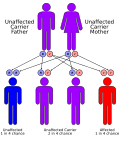Ataxia–telangiectasia
Ataxia-telangiectasia (A-T) is a rare, neurodegenerative, autosomal recessive disease causing severe disability. A-T is characterized by progressive cerebellar ataxia, telangiectasia, immune defects, and a high rate of cancer.
Etymology[edit]
The term "ataxia" comes from the Greek word "ataxis" which means "without order or incoordination". The term "telangiectasia" is derived from the Greek words "telos" meaning "end", "angeion" meaning "vessel", and "ektasis" meaning "dilation". This refers to the dilation of end vessels found in patients with the condition.
Symptoms and Signs[edit]
The symptoms and signs of A-T are diverse and include severe progressive cerebellar ataxia, oculomotor apraxia, immune defects, recurrent sinopulmonary infections, and an increased risk of malignancies, particularly of lymphoid origin.
Causes[edit]
A-T is caused by a mutation in the ATM gene, which is involved in DNA repair. This mutation leads to a decrease in the production of the ATM protein, which is crucial for the normal function of several other proteins involved in the cell cycle control and DNA repair.
Diagnosis[edit]
Diagnosis of A-T is based on clinical features, laboratory findings of IgA deficiency and increased alpha-fetoprotein, and molecular genetic testing of the ATM gene.
Treatment[edit]
There is currently no cure for A-T. Treatment is supportive and includes physical and occupational therapy, gamma-globulin injections to boost the immune system, and high-dose vitamins.
Prognosis[edit]
The prognosis for individuals with A-T is poor. Most people with A-T become wheelchair-bound by their teens and do not survive past their early twenties.
See Also[edit]
|
|
|
-
Ocular telangiectasia in a person with A-T
-
Autosomal recessive inheritance pattern
-
Alu element ATM insertion
-
Characteristics of the ATM protein
-
ATM and the immune system
-
Comparison of rare genetic disorders that can be confused with A-T
-
Mechanism of action of antisense oligonucleotides (ASOs)
Ad. Transform your life with W8MD's Budget GLP-1 injections from $75


W8MD offers a medical weight loss program to lose weight in Philadelphia. Our physician-supervised medical weight loss provides:
- Weight loss injections in NYC (generic and brand names):
- Zepbound / Mounjaro, Wegovy / Ozempic, Saxenda
- Most insurances accepted or discounted self-pay rates. We will obtain insurance prior authorizations if needed.
- Generic GLP1 weight loss injections from $75 for the starting dose.
- Also offer prescription weight loss medications including Phentermine, Qsymia, Diethylpropion, Contrave etc.
NYC weight loss doctor appointmentsNYC weight loss doctor appointments
Start your NYC weight loss journey today at our NYC medical weight loss and Philadelphia medical weight loss clinics.
- Call 718-946-5500 to lose weight in NYC or for medical weight loss in Philadelphia 215-676-2334.
- Tags:NYC medical weight loss, Philadelphia lose weight Zepbound NYC, Budget GLP1 weight loss injections, Wegovy Philadelphia, Wegovy NYC, Philadelphia medical weight loss, Brookly weight loss and Wegovy NYC
|
WikiMD's Wellness Encyclopedia |
| Let Food Be Thy Medicine Medicine Thy Food - Hippocrates |
Medical Disclaimer: WikiMD is not a substitute for professional medical advice. The information on WikiMD is provided as an information resource only, may be incorrect, outdated or misleading, and is not to be used or relied on for any diagnostic or treatment purposes. Please consult your health care provider before making any healthcare decisions or for guidance about a specific medical condition. WikiMD expressly disclaims responsibility, and shall have no liability, for any damages, loss, injury, or liability whatsoever suffered as a result of your reliance on the information contained in this site. By visiting this site you agree to the foregoing terms and conditions, which may from time to time be changed or supplemented by WikiMD. If you do not agree to the foregoing terms and conditions, you should not enter or use this site. See full disclaimer.
Credits:Most images are courtesy of Wikimedia commons, and templates, categories Wikipedia, licensed under CC BY SA or similar.
Translate this page: - East Asian
中文,
日本,
한국어,
South Asian
हिन्दी,
தமிழ்,
తెలుగు,
Urdu,
ಕನ್ನಡ,
Southeast Asian
Indonesian,
Vietnamese,
Thai,
မြန်မာဘာသာ,
বাংলা
European
español,
Deutsch,
français,
Greek,
português do Brasil,
polski,
română,
русский,
Nederlands,
norsk,
svenska,
suomi,
Italian
Middle Eastern & African
عربى,
Turkish,
Persian,
Hebrew,
Afrikaans,
isiZulu,
Kiswahili,
Other
Bulgarian,
Hungarian,
Czech,
Swedish,
മലയാളം,
मराठी,
ਪੰਜਾਬੀ,
ગુજરાતી,
Portuguese,
Ukrainian







